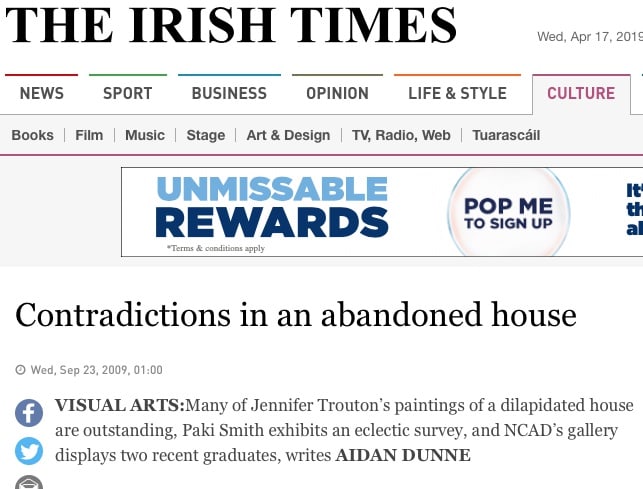Contradictions in an abandoned house
Many of Jennifer Trouton's paintings of a dilapidated house are outstanding, Paki Smith exhibits an eclectic survey, and NCAD's gallery displays two recent graduates, writes AIDAN DUNNE
JENNIFER TROUTON'S exhibition Still, at the Molesworth Gallery, is a pictorial exploration of an abandoned house, from external views of its faded wooden walls and broken windows to snapshots of its worn interior, littered with fragmentary and broken possessions. That's one way of looking at it, at any rate, though there is no guarantee of exact continuity between the various images, and there are some indications that more than one location is involved. The exterior views, of a dilapidated house resembling a vernacular American clapboard farmhouse, are consistent, and evoke the kind of homesteads familiar from various literary and artistic sources, including Andrew Wyeth's paintings. They also recall films, and almost all the images in the show have a photographic character, with selectively sharp and softer focus, for example.
With the paintings that depict interiors, though, while we can assume we are seeing what's inside the house, it's not quite clear-cut. There are studies of surprisingly pristine-looking swathes of decorative cloth, as well as more obvious scenes of localised decay.
Trouton is a skilled, meticulously realist painter who has been consistently interested in the layers and contradictions inherent in the idea of a single, coherent surface. Her previous show, Ellipses, anatomised an urban house, discerning in its decorative history and the traces of its departed inhabitants' stories of hopes and disappointments, dreams and realities. In the context of the domestic, the evident, integral surface, she implied, is temporary, necessarily incomplete, full of gaps and clues, and always just an episode in an unfolding drama. It reflects the fleeting human presence.
In one sequence of paintings in Still, we see printed patterns worn down and destroyed by time. They could be symbolic of our best-laid plans and schemes. Overall, a certain unease emanates from the images. There is something slightly forbidding about the abandoned house, and such details as broken crockery and - a particularly strong painting - a doll's head on the floor could hint at a violent event.
